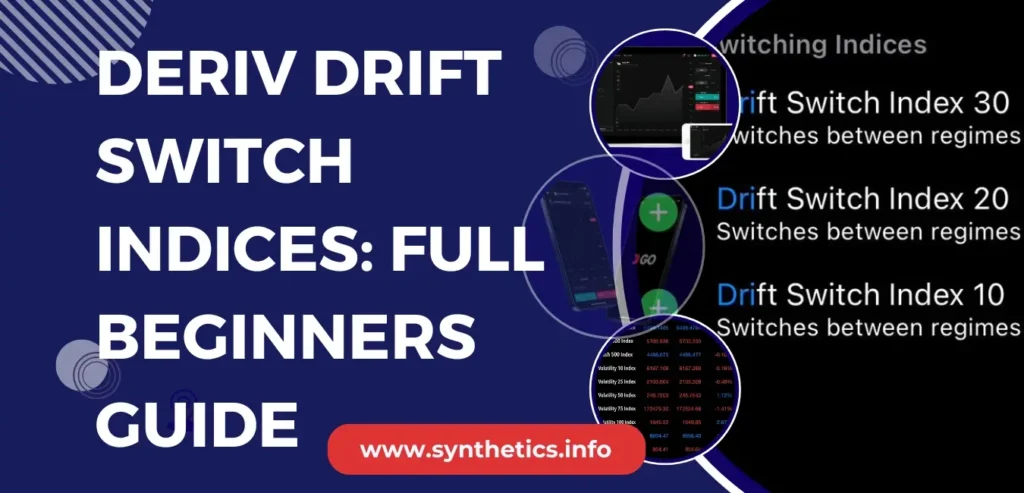Drift Switch Indices are some of the most rhythm-based synthetic markets Deriv has ever released. But are they actually tradable? Let’s break them down.
👀 What Are Deriv Drift Switch Indices?
Drift Switch Indices (DSI) are synthetic indices that switch between three distinct trends:
- 📈 Positive Drift (Bullish phase)
- 📉 Negative Drift (Bearish phase)
- ➖ Driftless (Sideways phase)
Unlike the random spikes of Crash/Boom or the sharp reversals in Jump Indices, DSI assets follow structured “market moods” — and flip between them every 10 to 30 minutes, depending on the index.
They were released in September 2023 and are steadily gaining popularity ever since.
📚 New to synthetics in general? Read our full guide to Synthetic Indices on Deriv to understand how DSI fits into the bigger picture.
 Read Review
OPEN AN ACCOUNT
Read Review
OPEN AN ACCOUNT
Min Deposit: USD 1
Total Pairs: 100+
Regulators: MFSA, LFSA, VFSC, BVIFSC
📊 List of Available Deriv Drift Switch Indices
| Symbol | Description | Average Switch Time |
|---|---|---|
| DSI 10 | Fast-paced trend switches | 10 minutes |
| DSI 20 | Balanced trend behavior | 20 minutes |
| DSI 30 | Slower shifts, more stable | 30 minutes |
You can trade all three on Deriv MT5 under the Derived > Drift Switch category.
To access these markets, you’ll need a Deriv Financial MT5 account.
👉 Follow this guide to open one
🔄 How These Indices Behave
Each DSI mimics a classic market cycle:
- Growth (Bullish)
- Consolidation (Sideways)
- Recession (Bearish)
Unlike real-world markets, DSI movements are not affected by news or events. The transitions are coded to occur regularly, not randomly — making them ideal for structured strategy development. They are a special type of synthetic indices.
These regime flips follow an internally programmed timer . You may not know the exact second a flip occurs, but over time, you’ll spot patterns like:
- Trend “tiring” near the 9–10 minute mark (for DSI 10)
- Sideways drift before a breakout into a new phase

💠 DSI Minimum Lot Size
All Drift Switch Indices on Deriv support micro lot trading, which makes them ideal for small accounts and testing.
| Index | Minimum Lot Size |
|---|---|
| DSI 10 | 0.01 |
| DSI 20 | 0.01 |
| DSI 30 | 0.01 |
You can manually adjust lot size in MT5 when placing your order. These micro lots give you precise control over risk — perfect if you’re starting with $10–$50.
💰 DSI Margin and Minimum Equity Requirements
Drift Switch Indices are extremely margin-light. In your live test:
- DSI 10 & 20 required only ~$0.02 margin for 0.01 lots
- DSI 30 required slightly more — ~$0.04
That means even a $5–$10 balance is enough to open a trade.
However, for real cushion and breathing room, it’s safer to trade with at least $20+ to survive small losses or multiple trades.
| Index | 0.01 Lot Margin Used | Suggested Minimum Equity |
|---|---|---|
| DSI 10 | ~$0.02 | $10–$20 |
| DSI 20 | ~$0.02 | $10–$20 |
| DSI 30 | ~$0.04 | $15–$25 |
📌 All values tested on a $166 account using Deriv MT5 on July 3, 2025.

📉 3. DSI Spreads and Swaps (Real Example)
When you place a trade, you’ll immediately notice a small floating loss — that’s your spread cost.
In your tests using 0.01 lots:
| Index | Spread (Floating Loss at Entry) |
|---|---|
| DSI 10 | $0.00 |
| DSI 20 | $0.05 |
| DSI 30 | $0.07 |
Spreads widen slightly during regime transitions (just before a flip), which is normal. But they remain tight and affordable compared to volatile assets like V75.
📆 Swaps
If you hold your trade overnight, a small swap fee is charged. Deriv reports this at around 7.5% annually, which comes to:
- ~$0.02–$0.03 per night on 0.01 lots
For most short-term traders, this is negligible — but scalpers and swing traders should be aware of it.
📊 Comparing DSI to Other Popular Synthetic Indices
🟦 DSI 10 / 20 / 30
These indices follow a predictable rhythm — trending up or down, pausing, then switching direction every 10 to 30 minutes. If you prefer timing your trades based on structured cycles, DSI offers that edge.
🔗 (You’re already in the right guide.)

🟧 Boom / Crash Indices
Expect sudden spikes without warning. These assets don’t follow a clear rhythm — which makes them great for scalpers who wait for explosive one-tick moves.
🔗 See Boom & Crash Indices Overview
🟥 Jump Indices
Jump indices tend to move erratically with big bursts in one direction, then snap back. If you like fading exaggerated moves or trading tight ranges, these could fit your style.
🔗 Explore the Jump Indices Guide
🟩 Step Index
This is one of the smoothest synthetic assets — price action tends to “walk” rather than “jump.” It’s well-suited for slower-paced trading or testing new strategies on low volatility.
🔗 Read the Step Index Guide
My Practical Tips for Trading Drifit Switch Indices
1. Trade the Mood, Not the Candle
Always identify the current trend phase before entering. Don’t just jump in mid-way — you’ll get chopped.
2. Watch the Clock
If you’re on DSI 10, know that flips tend to occur every ~10 minutes. Use a simple countdown timer. Enter near the beginning of a regime, not near the end.
3. Use Basic Confirmation Tools
A moving average or RSI might help you confirm trend continuation. But the real edge comes from timing — not indicators.
4. Always Use SL & TP
These indices switch fast. A winning trade can turn against you within seconds if you’re not protected.
🖥️ Need Help Setting Up MT5 for DSI?
If you’re new to MetaTrader 5 or just not sure how to load Drift Switch Indices onto your charts, don’t worry — I’ve got you covered. Whether you’re trading from mobile or desktop, this walkthrough shows you how to log in, add DSI to your watchlist, set stop loss and take profit, and manage open trades properly.
It’s the exact setup I wish I had when I was starting out — simple, clean, and trader-focused.

🔗 Related Guides
🧵 Final Thoughts
The real opportunity with Drift Switch Indices lies in patience and pattern recognition.
If you take the time to learn the rhythm, this may be one of the most tradable synthetic index types available on Deriv right now.
Seen anything strange while trading DSI? Drop a comment and share your experience — let’s compare notes.
FAQs On Deriv Drift Switch Indices
rift Switch Indices are synthetic assets that alternate between uptrend, downtrend, and sideways movement after set time intervals — typically 10, 20, or 30 minutes.
They are only available on Deriv MT5, not on TradingView or Deriv X.
DSI flip based on a time rhythm, while Boom & Crash spike randomly based on tick logic.
It depends on your style. DSI 10 is faster, better for scalping. DSI 30 is slower, more stable for swing entries.






💼 Recommended Brokers to Explore
Other Posts You May Be Interested In
HFM Pro Account Review 🔍Features, Pros & Cons
📅 Last updated: October 31, 2023 ✍️ Written by: Jafar Omar ✅ Fact-checked by: Taylor [...]
Best Time to Trade Boom & Crash Indices on Deriv (2025 Day & Session Map)
📅 Last updated: July 10, 2025 ✍️ Written by: Jafar Omar ✅ Fact-checked by: Taylor [...]
10 Least Volatile Volatility Indices on Deriv (Full 2025 Guide) 🐢
📅 Last updated: June 12, 2025 ✍️ Written by: Jafar Omar ✅ Fact-checked by: Taylor [...]
Best Tips For Trading Synthetic Indices & Strategies (2025 Updated Guide)💰
📅 Last updated: June 13, 2025 ✍️ Written by: Jafar Omar ✅ Fact-checked by: Taylor [...]
Advantages & Disadvantages of Trading Synthetic Indices on Deriv in 2025 💹
📅 Last updated: June 12, 2025 ✍️ Written by: Jafar Omar ✅ Fact-checked by: Taylor [...]
How to Open a Deriv Demo Account on MT5 – Step-by-Step Guide (2025) ✔
📅 Last updated: March 4, 2025 ✍️ Written by: Jafar Omar ✅ Fact-checked by: Taylor [...]